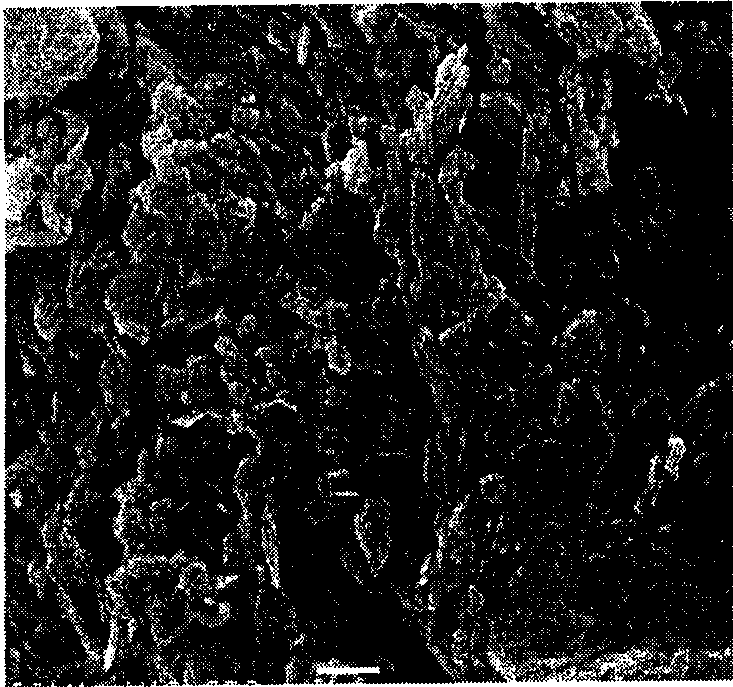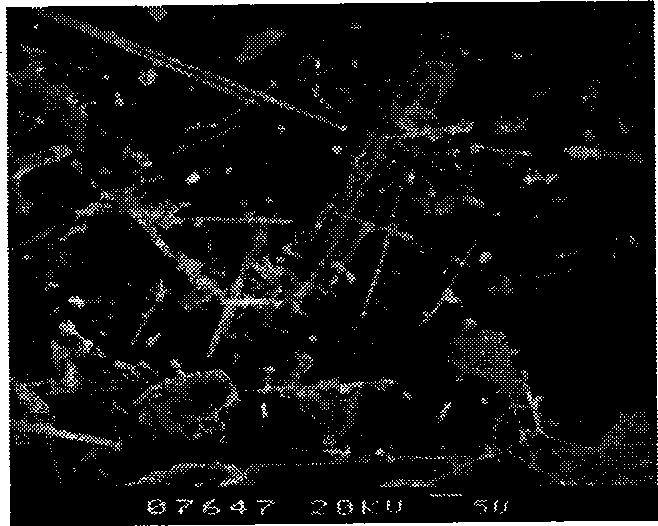Method for preparing supported nano TiO2 composite photocatalysis material by microwave
A technology of composite photocatalysis and photocatalytic materials, which is applied in the field of preparing non-metallic mineral-supported nano-TiO2 composite photocatalytic materials by microwave method, can solve the problems of poor wastewater capacity effect, poor capacity effect, poor loading effect, etc., and achieves low cost, The effect of improving practical ability and improving activity
- Summary
- Abstract
- Description
- Claims
- Application Information
AI Technical Summary
Problems solved by technology
Method used
Image
Examples
Embodiment 1
[0045] Embodiment 1: Zeolite is carrier, tetrabutyl titanate is precursor
[0046] Add 10ml tetrabutyl titanate to 50ml ethanol and stir to form a transparent light yellow solution A, add 10ml glacial acetic acid to solution A and stir at 50°C for 1 hour to form transparent TiO 2 Sol, adjust the pH value of this sol to 1.5, and stir to generate a transparent solution B. Add 0.8 g of zeolite-based minerals to solution B, stir for 10 minutes, heat for 5 minutes at a microwave power of 250W, wash with water and use centrifugal dehydration until the supernatant is close to neutral, filter and dehydrate the cake at 80°C Drying and calcining at 200° C. for 2.5 hours to obtain 2 grams of nano-titanium dioxide photocatalytic material product.
[0047] For the photocatalytic degradation effect of simulated printing and dyeing wastewater Rhodamine B, the photocatalytic degradation conditions are: the natural pH value of Rhodamine B solution is the initial pH value of the solution, the ...
Embodiment 2
[0048] Example 2: According to the preparation method of Example 1, the microwave heating time is 10 minutes, the calcination temperature is 300°C, the calcination time is 2.5 hours, and the microwave power is 250W. The photocatalytic degradation conditions are: the natural pH value of Rhodamine B solution is the initial pH value of the solution, the concentration of Rhodamine B is 0.15mmol / L, the amount of photocatalyst is 5g / L, the light reaction time is determined at 1.5 hours, and the ultraviolet The light intensity adopts an 8W ultraviolet lamp tube, and the degradation rate is 91.56%.
Embodiment 3
[0049] Embodiment 3: according to the preparation method of example 1, the photocatalytic degradation condition is: the pH value of Rhodamine B solution is 7.81, the concentration of Rhodamine B solution is 0.05mmol / L, the consumption of photocatalyst is 15g / L, light reaction The time is determined to be 1.5 hours, and the ultraviolet light intensity adopts a 24W ultraviolet lamp tube, and the degradation rate is 94.37%.
PUM
| Property | Measurement | Unit |
|---|---|---|
| particle diameter | aaaaa | aaaaa |
Abstract
Description
Claims
Application Information
 Login to View More
Login to View More - R&D
- Intellectual Property
- Life Sciences
- Materials
- Tech Scout
- Unparalleled Data Quality
- Higher Quality Content
- 60% Fewer Hallucinations
Browse by: Latest US Patents, China's latest patents, Technical Efficacy Thesaurus, Application Domain, Technology Topic, Popular Technical Reports.
© 2025 PatSnap. All rights reserved.Legal|Privacy policy|Modern Slavery Act Transparency Statement|Sitemap|About US| Contact US: help@patsnap.com



